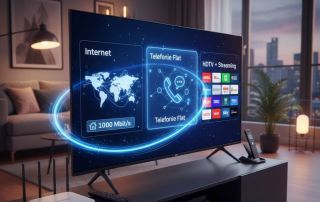How smart home devices spy on us
Smart home devices have become indispensable in modern households. They offer comfort, security, and efficiency. But behind this facade of convenience lurk potential dangers: These intelligent devices collect and transmit extensive data about our daily activities. In this article, we take a critical look at the data collection practices of smart home devices, highlight the risks, and provide practical tips for protecting your privacy.

The invisible eyes: What data do smart home devices collect?
Smart home devices such as smart speakers, thermostats, security cameras, and lighting systems are designed to analyze and adapt our lifestyles. But what data do these devices actually collect? The answer is complex and often unsettling.
1. Usage habits and routines
Smart thermostats record detailed information about when you are at home and what temperatures you prefer. This data is used to make heating and cooling systems more efficient, but it also reveals a lot about your daily routines. Lighting systems remember when and where you turn the lights on and off, which also allows conclusions to be drawn about your habits and presence.
2. Voice recordings and communication
Voice-controlled assistants like Amazon Alexa, Google Home, or Apple Siri record and store your voice commands. These recordings contain not only your direct commands but also often accidentally activated snippets of speech that may include private conversations and intimate details. This data is stored on servers and can potentially be analyzed by the companies or accessed through security vulnerabilities.
3. Movement and location data
Security cameras and motion detectors continuously log your movements in and around your home. While this data helps make your home more secure, it can also create detailed movement profiles that show exactly when and where you are. GPS-enabled devices such as smart locks or connected cars collect location data that can be used similarly to track your daily routes and whereabouts.
4. Health and fitness data
Some smart home devices, such as smart scales or health trackers, collect and store data about your health and fitness activities. This data ranges from your weight and heart rate to sleep patterns and physical activity. This sensitive information can offer valuable insights into your health and lifestyle, but it also requires special protection.
5. Consumption and entertainment habits
Smart TVs, streaming devices, and other consumer electronics collect information about your viewing habits, including which movies and series you watch and when. This data can be used not only for marketing purposes but also to draw conclusions about your interests and personal preferences.
6. Household activities and appliance conditions
Many Smart Home devices communicate with each other and share information about their status and usage. A smart refrigerator, for example, can collect data on the frequency and timing of opening and closing, as well as the contents and consumption of stored food. Smart washing machines and dishwashers record when and how often they are used. This collected data offers detailed insights into your household habits and can be used to analyze your consumption patterns.
The sheer volume of data collected creates a comprehensive profile of your daily activities and preferences that goes far beyond simple usage statistics. The danger lies in the fact that this data – whether intentionally by the manufacturers or through potential security vulnerabilities – could be misused to gain personal and intimate insights into your life.
The risks: How smart home devices endanger our privacy
The extensive data collection by smart home devices poses serious privacy risks. These risks can manifest themselves in various ways:
1. Data leaks and hacking attacks
Hacking attacks on smart home devices are not uncommon. Attackers exploit vulnerabilities in the software or weak passwords to gain access to the devices. Once compromised, hackers can steal sensitive data, including video footage from security cameras, voice recordings, or even information about your daily routines. This data can then be used for criminal activities such as burglaries, identity theft, or extortion.
2. Sharing and selling data
Manufacturers of smart home devices often have complex privacy policies that allow them to sell collected data to third parties. This practice can result in your private information being shared without your knowledge. The data can be used by advertisers to deliver targeted ads or resold by data brokers. In some cases, the data may even be shared with government agencies, raising questions about surveillance and privacy protection.
3. Surveillance and abuse
In extreme cases, smart home devices can be used for surveillance and abuse. For example, security cameras can be used by stalkers or abusive partners to monitor victims. Strangers who gain access to these devices could also spy on your movements and activities. This poses a threat not only to privacy but also to the physical safety of those affected.
4. Unauthorized access by insiders
In addition to external threats, there is also the risk of unauthorized access by individuals working within the company that manufactures the devices or provides the services. Insiders may be able to access and misuse stored data. Such cases can be particularly problematic because they are often more difficult to detect and prevent.
5. Unintentional data disclosure
Some smart home devices can unintentionally disclose sensitive data due to misconfiguration or software errors. For example, security cameras could make live-recorded videos publicly accessible without the users’ knowledge. Similarly, voice assistants could send private conversations to third parties if they are incorrectly activated.
6. Psychological effects and stress
Knowing you are constantly being monitored can cause psychological stress. Studies show that people who are aware they are being watched by their own devices are more likely to make behavioral changes. This kind of self-censorship can lead to unnatural behavior and negatively impact overall well-being.
7. Legal grey areas
The legal framework for the use and protection of data collected by smart home devices is often unclear and varies by country and region. This uncertainty can make it difficult for consumers to understand and enforce their rights. In some cases, legal gray areas may also be exploited to collect and use data in ways that the user does not expect or understand.
8. Infringements on personal autonomy
By collecting extensive data about your preferences and routines, smart home devices can lead to the increasing automation of decisions that were previously made by humans. This can restrict personal autonomy and result in people having less control over their own lives and decision-making processes.
Security measures: How to protect your smart home devices
Despite the risks mentioned, there are numerous measures you can take to make your smart home devices more secure and protect your privacy. Here are some advanced tips and strategies to help you stay in control of your data:
1. Strong passwords and two-factor authentication
Use unique, strong passwords for each device. A strong password should consist of a combination of uppercase and lowercase letters, numbers, and special characters. If possible, enable two-factor authentication (2FA). This additional layer of security makes it harder for attackers to gain access to your devices, even if they crack your password.
2. Regular software updates
Keep your devices’ firmware and software up to date. Manufacturers regularly release security updates that close known vulnerabilities. Enable automatic updates when available, or set reminders to manually check for and install updates.
3. Check privacy settings
Check the privacy settings of your devices and limit the amount of data collected. Many smart home devices offer options to disable the storage of voice recordings, movement profiles, and other sensitive data. Read the privacy policies carefully and make sure you understand what data is collected and how it is used.
4. Increase network security
Use a separate network for your smart home devices and secure it with strong encryption. A separate network can prevent attackers who compromise one device from gaining access to your entire home network. Invest in a high-quality router that offers security features such as a firewall, intrusion detection, and VPN support.
5. Using a VPN (Virtual Private Network)
A VPN encrypts your internet traffic and hides your IP address, making it harder for hackers to access your data. Install a VPN on your router to protect all traffic on your network. This is especially useful if you access your smart home devices remotely.
6. Deactivate unnecessary functions
Deactivate features you don’t need or use. For example, on a smart speaker, you can turn off the microphones when you’re not using them. This reduces the risk of private conversations being accidentally recorded.
7. Using guest networks
If guests are using your Wi-Fi, set up a separate guest network. This separates your visitors’ devices from your smart home devices and reduces the risk of an infected guest device compromising your network.
8. Check devices regularly
Perform regular security checks on your smart home devices. Check which devices are connected to your network and remove any unknown or no longer needed devices. Use network scanning tools to detect suspicious activity.
9. Make conscious purchasing decisions
Before buying a new smart home device, research the manufacturer’s security practices. Prefer brands known for their security measures and transparency regarding data privacy. Read reviews and research any known security incidents related to the product.
10. Awareness raising and training
Raise awareness among all household members about the risks of smart home technology and train them in the safe use of the devices. Everyone in the household should understand the importance of strong passwords, regular updates, and secure usage.
Conclusion:
Smart home devices undoubtedly offer many advantages, but they also pose significant privacy risks. By being aware of the potential dangers and taking appropriate safeguards, you can make your smart home environment more secure and better protect your personal data.
It’s important to consider not only the convenience and comfort of the technology but also the potential risks associated with using these devices. Data privacy and security should not be an afterthought but an integral part of using smart home devices. By applying the security strategies described, you can maintain control over your data and minimize the risks. Responsibility lies with both manufacturers and users. Manufacturers must ensure that their products are equipped with robust security measures and offer clear, transparent privacy policies. Users should actively take care of the security of their devices by using strong passwords, performing regular updates, and securing their networks.
Continuously monitoring emerging security threats and solutions is also essential. Technology is constantly evolving, and so are the methods used by cybercriminals. Stay informed about current security practices and adapt your protective measures accordingly.
Furthermore, privacy awareness plays a crucial role. Always be aware of what data your devices collect and how it is used. Utilize the privacy options your devices offer and limit the data you share. Ultimately, you can fully leverage the benefits of smart home technologies by proactively managing your data security. With the right measures, you can create a safe and comfortable home that respects and protects your privacy. This allows you to get the most out of modern technology without compromising your security and privacy.
Beliebte Beiträge
Salary negotiation: 5 phrases that can get you up to 15% more
Want a 15% raise? A successful salary negotiation depends on preparation and the right words. We'll show you five phrases you need to use – from setting the anchor to responding to a "no." This is how you argue persuasively.
Die besten Live-Übersetzer-Earbuds im Check
Schluss mit Sprachbarrieren! Moderne Earbuds wie Google Pixel Buds & Timekettle übersetzen Gespräche live. Wir zeigen die besten Modelle, erklären die KI-Technik, nennen die Kosten und zeigen, wo die Technologie noch an ihre Grenzen stößt.
So sieht das wirklich perfekte Homeoffice-Setup für 2026 aus
Ihr Homeoffice ist veraltet? Steigern Sie 2026 Produktivität & Gesundheit. Unser Guide zeigt das perfekte Setup: von ergonomischen Stühlen und 4K-Webcams bis zu Mesh-WLAN und Kabelmanagement. So investieren Sie in Ihre Karriere.
Internet, Telefon & TV: Die besten Komplettpakete
Internet, TV & Telefon aus einer Hand? Wir vergleichen die Komplettpakete von Telekom, Vodafone, O2 & 1&1. Wer punktet bei Speed, TV-Komfort (MagentaTV vs. GigaTV) und Preis? So finden Sie das beste Triple-Play-Angebot für Ihre Adresse.
How we all turned Google into our monopolist
Google's monopoly is homegrown – created by us. We chose the superior search engine, "free" services like Gmail and Maps, and ignored the competition. In exchange for convenience, we gave away our data and created the monopolist ourselves.
Das HBO-Portfolio zerbricht: Was Sky-Kunden 2026 verlieren
Sky & WOW verlieren 2026 die exklusiven HBO-Rechte, da HBO Max in Deutschland startet. Neue Top-Serien wie die "Harry Potter"-Serie laufen künftig exklusiv bei Max. Überraschend: Laufende Hits wie "House of the Dragon" bleiben Sky-Kunden erhalten. Alle Details zur neuen Streaming-Lage.

































